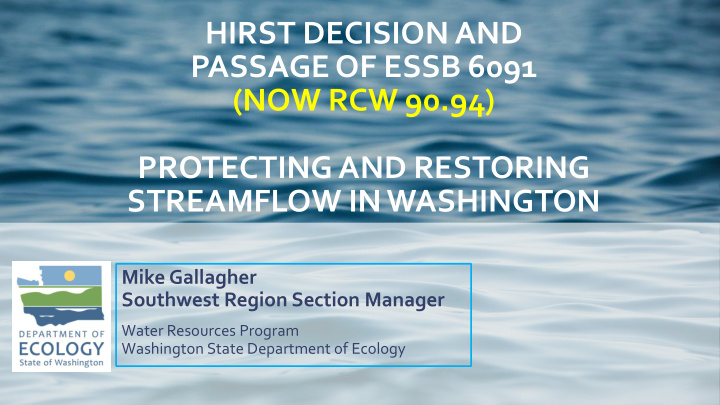



HIRST DECISION AND PASSAGE OF ESSB 6091 (NOW RCW 90.94) PROTECTING AND RESTORING STREAMFLOW IN WASHINGTON Mike Gallagher Southwest Region Section Manager Water Resources Program Washington State Department of Ecology
We manage water resources to meet the needs of people and the natural environment, in partnership with Washington communities.
Overview • Legal background of Hirst • Overview of ESSB 6091 • Implementation of RCW 90.94
Streamflow protection case law 2000: Postema decision: Ecology cannot authorize impairment no matter how small ( de minimus ) 2013: Swinomish decision: Ecology cannot reallocate water instream flow for out-of-stream use (reinforce standard of no de minimus impairment is allowed) 2015: Foster decision: Ecology must protect the flow of water from impairment no matter if the biological impairment has been addressed
Whatcom County v. Hirst, et al. (2016) Appeal of Whatcom County’s Comprehensive Plan. The WA Supreme Court ruled that the plan failed to sufficiently protect water resources under the Growth Management Act. Counties have an independent responsibility to ensure that new permit-exempt uses do not impair senior uses, including instream flows Cannot allow even de minimus impairment Must “go beyond” state rules if needed to meet GMA obligations Source: RethinkRural
Major themes of 2017 Legislature Hirst important priority, yet no agreement on resolution • Senate Republican majority; House Democrat majority; Democratic Governor all had different positions • No agreement on what needed to be done (if anything) • About 20 different “Hirst bills” introduced • Fundamental split on many issues • Longest session in history ended without agreement $4 billion capital budget held up – tied to Hirst resolution
2018: Early legislative agreement “Go big” • Little disagreement around streamflow and salmon habitat needs • Disagreement was about impact from permit-exempt wells • Agreement was reached when the Legislature focused on the overall goal to improve streamflows • Statewide funding of $300M over 15 years to do much more than simply offsetting permit-exempt well impacts ESSB 6091 passed the Legislature and was signed into law by Gov. Inslee on January 19, 2018.
Key elements of ESSB 6091 [now RCW 90.94] In Hirst Basins (15 impacted Watersheds): People can build homes using a permit-exempt • well; potential impacts authorized $500 fee for each new home • Water use restrictions • Planning process in each “Hirst” basin • Statewide: Counties can rely on Ecology rules for GMA • compliance Impacts offset through streamflow restoration • projects ($300M for 15 years)
RCW 90.94 overview, continued • Only placed new requirements on new domestic wells in certain basins. Did not affect: Instream flow rules with specific requirements for • permit-exempt uses Wells drilled before the bill passed • Commercial buildings • • Pilot program for metering domestic uses in two basins (Dungeness and Kittitas) • Legislative task force to study the WA Supreme Court’s Foster decision; 5 Foster pilot projects authorized • Reporting to the Legislature
Implementing RCW 90.94: Planning Planning requirements are different in different basins: Timeframes for completion • How committees are formed and what entities are • part of the process What happens if there’s not agreement • Planning elements which are the same: Plans must identify actions necessary to offset the • consumptive impact from new permit-exempt wells Plans must prioritize “in -time and in- place” • Plans must meet a “net ecological benefit” standard •
One year timeframe in • WRIAs 1 and 11 Some basins rely on • Chapter 90.82 RCW planning units Ecology invites entities in • other basins for planning committees Basins with instream flow • rules that regulate permit-exempt uses “Other” requirements •
Implementing RCW 90.94 Ongoing Actions… Ecology’s role: • Leading and participating in planning. • Evaluating and approving plans. • Financial support and selection of projects. Ongoing steps (since January 19, 2018) : Staffing (adding about 12-15 new staff) • Funding criteria • Defining Net Ecological Benefit • Launching planning groups in designated • WRIAs Developing policy, guidance and rules •
Key Issues How much priority should there be for “in - • time and in- place” mitigation? How should we determine “net ecological • benefit”? How will Ecology make funding decisions in • current biennium?
Next Steps Bringing on needed resources and • helping our organization through major changes Developing the process for funding • criteria and net ecological benefit standards Evaluate how to help existing • planning groups succeed? New committees = new challenges • Many disagreements on aspects of • the new legislation – what are the requirements? How to work through disagreements toward successful outcomes?
Streamflow restoration web page • Overview of the law • Guidance documents • Historical watershed planning documents • Regional contact information https://ecology.wa.gov/Water-Shorelines/Water-supply/Streamflow-restoration
Big Challenge: Fitting the wide variation in precipitation/recharge, surficial water supply and complex hydrogeological conditions with legal and Court directed statutes/decisions…
Questions? Thank you Mike Gallagher Department of Ecology Water Resources Program (360) 407-6058 Mike.Gallagher@ecy.wa.gov
Recommend
More recommend